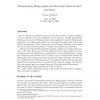147 search results - page 10 / 30 » Cycle decompositions of the complete graph |
EJC
2008
13 years 6 months ago
2008
For a graph G and a set D V (G), define Nr[x] = {xi V (G) : d(x, xi) r} (where d(x, y) is graph theoretic distance) and Dr(x) = Nr[x] D. D is known as an r-identifying code if...
SIROCCO
2001
13 years 9 months ago
2001
This paper considers the design of a survivable WDM network based on covering the initial network with sub-networks, which are protected independently from each other. We focus on...
IROS
2007
IEEE
14 years 2 months ago
2007
IEEE
Abstract— We present an efficient algorithm for complete motion planning that combines approximate cell decomposition (ACD) with probabilistic roadmaps (PRM). Our approach uses ...
CORR
2008
Springer
13 years 8 months ago
2008
Springer
In the constraint programming framework, state-of-the-art static and dynamic decomposition techniques are hard to apply to problems with complete initial constraint graphs. For suc...
JCT
2008
13 years 8 months ago
2008
A hole in a graph is an induced cycle on at least four vertices. A graph is Berge if it has no odd hole and if its complement has no odd hole. In 2002, Chudnovsky, Robertson, Seym...

